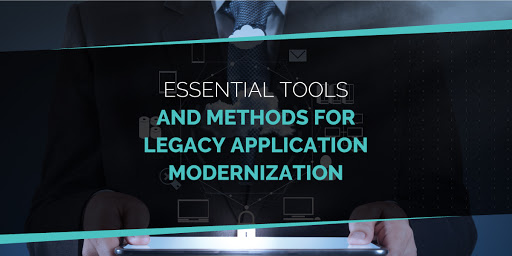
We talked about cloud-readiness assessments and the benefits of modernizing legacy systems, but what are the essential tools and methods for modernizing legacy applications?
4 Ways to Implement a Legacy Application Modernization
1. Re-Hosting
One of the most popular methods we see is re-hosting (aka “lift & shift”).
Re-hosting is basically taking applications that have little impact on business operations and are -- in technical terms -- easy to move to an IaaS (Infrastructure as a Service) or SaaS (Software as a Service) environment.
It's about re-deploying applications without touching the source code. Rather, we move it from a hardware environment to a third-party hosted virtualized cloud environment.
2. Re-Factoring
The second method we see is refactoring.
Re-Factoring should be used for applications that have a high impact on businesses and are technically easy to move to a PaaS (Platform as a Service) environment.
When you move to a PaaS environment like Azure, you gain many add-on services that you wouldn’t need to build from scratch but can integrate off-the-shelf.
3. Re-Architecting
The third one is re-architecting, which brings the greatest amount of benefits to businesses.
Consider Re-Architecting for your high impact business applications that have organizational, technical or architectural hurdles which are preventing migration to the cloud.
You need to come up with a new architecture or decompose these monolithic applications into smaller services, and then design a different way of automating or integrating them.
A Modernization Assessment is the Best way to Choose the Right Legacy Modernization Method that Works for You
[ld_button title="Get an Application Migration Assessment" link="url:%2Fapplication-modernization-assessment%2F||target:%20_blank|" color="#3fc8c4" text_color="rgb(0, 0, 0)" el_class="arch-btn"]
4. Rebuilding
The fourth one is rebuilding.
Save a Rebuild for high impact business applications whose codes are outdated and written many years ago with obsolete technologies and languages -- these applications need a total rewrite.
We often see applications that need a rebuild. After an assessment, we see that they have good potential and are worth keeping. There are workable methods to rebuild a legacy system for the cloud.
And lastly, retaining and replacing
While technically not modernization strategies, there are two more approaches to consider.
Retaining is used when an application doesn't have any criticality for the business. It may have very low business value, and there are often many dependencies in architecture, technology or third-party applications.
Nobody wants to touch these, and instead, they just keep them as-is.
The second approach is replacing an application with another commercial offering, such as moving from a home-grown time tracking solution to a cloud-based SaaS product.
Application Modernization Tools: Microservices and Containers
To summarize overall, we’re looking at: re-hosting, refactoring, re-architecting, and rebuilding as the four main modernization strategies, and considering retaining or replacing when appropriate.
Now let’s look at some key mechanisms for modernizing legacy applications within the above 4 methods.
Microservices
‘Microservices’ is a variant of the service-oriented architecture (SOA).
Rather than building monolithic applications, you structure the application as a collection of loosely coupled services that implement business logic. This significantly increases the overall agility and maintainability of applications.
In essence, what you're doing with Microservices is taking a large monolithic software and decomposing it into smaller apps that can you can easily, rapidly and independently change, adapt and redeploy.
Containers
A container is a technology that ‘abstracts’ the applications from the environment in which they actually run. You’d get the flexibility to move from one platform to another easily.
This decoupling allows container-based applications to be deployed easily and consistently, regardless of whether the target environment is a private data centre, the public cloud, or even a developer’s personal laptop.
Containerization provides a clean separation of concerns, as developers focus on their application logic and dependencies, while IT operations teams can focus on deployment and management.
Read More on Application Modernization:
- 5 Reasons Why You Need to Re-Architect Applications for the Cloud
- 6 Benefits of Cloud-Native Applications for Business
Open Source Application Modernization Software is Now a Must
Open-source has become the mainstream for many organizations, and it’s an essential tool-kit for software developers looking to modernize a legacy system.
Proprietary Software Restricts Interoperability and Innovation
You may develop the greatest technology, but if it doesn’t easily integrate with other great technologies, you’ll limit your opportunities to innovate in the future.
The reason why companies are moving to open source is that they can quickly use what’s now available and get new tools or upgrades rapidly, so it keeps your business agile. Moreover, it’s more efficient to have a platform in which anyone can work on and collaborate.
It’s also cost-effective to a certain extent because you aren’t investing upfront, you're only investing when you need to upgrade or expand.
Examples of Open Source Software for Application Modernization
Kubernetes is a good example of open source technology for modernization. It was originally built by Google, but now, it’s an open-source system. Kubernetes has accelerated cloud adoption by making containerized applications the norm for business-critical services.
A few other noteworthy examples:
- OpenShift: a leader in the PaaS open source movement.
- Cloud Foundry: the industry standard, open source, PaaS that abstracts away infrastructure so you can focus on app innovation.
Enable Your In-House Team to Work in Kubernetes with a 2-Day Kubernetes Boot Camp.
[ld_button title="Get an Application Migration Assessment" link="url:%2Fapplication-modernization-assessment%2F||target:%20_blank|" color="#3fc8c4" text_color="rgb(0, 0, 0)" el_class="arch-btn"]
At Architech, we leverage best practices and frameworks from industry leaders (such as Microsoft, Ingram Micro, and Gartner) with internal knowledge and experience in application modernization, cloud-native technologies, and open-source development to help customers with their digital transformation journey.
Architech is a software development studio that leverages Agile Engineering approaches to modernize your applications with the capabilities and return-on-investment (ROI) gains you need. Contact us today to get started with a thorough assessment of your needs.






























